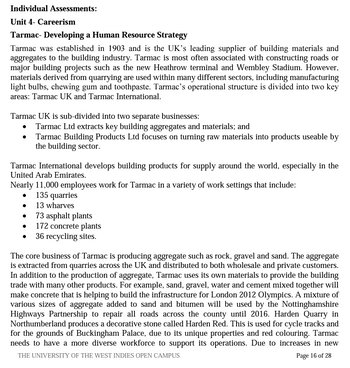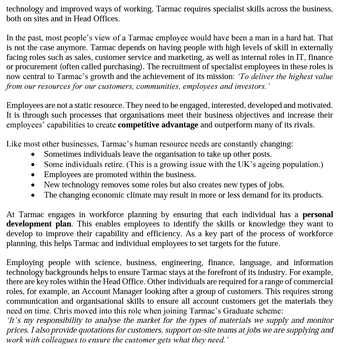
Understanding Business
12th Edition
ISBN: 9781259929434
Author: William Nickels
Publisher: McGraw-Hill Education
expand_more
expand_more
format_list_bulleted
Question

Transcribed Image Text:Individual Assessments:
Unit 4- Careerism
Tarmac- Developing a Human Resource Strategy
Tarmac was established in 1903 and is the UK's leading supplier of building materials and
aggregates to the building industry. Tarmac is most often associated with constructing roads or
major building projects such as the new Heathrow terminal and Wembley Stadium. However,
materials derived from quarrying are used within many different sectors, including manufacturing
light bulbs, chewing gum and toothpaste. Tarmac's operational structure is divided into two key
areas: Tarmac UK and Tarmac International.
Tarmac UK is sub-divided into two separate businesses:
Tarmac Ltd extracts key building aggregates and materials; and
• Tarmac Building Products Ltd focuses on turning raw materials into products useable by
the building sector.
Tarmac International develops building products for supply around the world, especially in the
United Arab Emirates.
Nearly 11,000 employees work for Tarmac in a variety of work settings that include:
135 quarries
13 wharves
73 asphalt plants
172 concrete plants
• 36 recycling sites.
The core business of Tarmac is producing aggregate such as rock, gravel and sand. The aggregate
is extracted from quarries across the UK and distributed to both wholesale and private customers.
In addition to the production of aggregate, Tarmac uses its own materials to provide the building
trade with many other products. For example, sand, gravel, water and cement mixed together will
make concrete that is helping to build the infrastructure for London 2012 Olympics. A mixture of
various sizes of aggregate added to sand and bitumen will be used by the Nottinghamshire
Highways Partnership to repair all roads across the county until 2016. Harden Quarry in
Northumberland produces a decorative stone called Harden Red. This is used for cycle tracks and
for the grounds of Buckingham Palace, due to its unique properties and red colouring. Tarmac
needs to have a more diverse workforce to support its operations. Due to increases in new
THE UNIVERSITY OF THE WEST INDIES OPEN CAMPUS
Page 16 of 28

Transcribed Image Text:technology and improved ways of working, Tarmac requires specialist skills across the business,
both on sites and in Head Offices.
In the past, most people's view of a Tarmac employee would have been a man in a hard hat. That
is not the case anymore. Tarmac depends on having people with high levels of skill in externally
facing roles such as sales, customer service and marketing, as well as internal roles in IT, finance
or procurement (often called purchasing). The recruitment of specialist employees in these roles is
now central to Tarmac's growth and the achievement of its mission: To deliver the highest value
from our resources for our customers, communities, employees and investors.'
Employees are not a static resource. They need to be engaged, interested, developed and motivated.
It is through such processes that organisations meet their business objectives and increase their
employees' capabilities to create competitive advantage and outperform many of its rivals.
Like most other businesses, Tarmac's human resource needs are constantly changing:
Sometimes individuals leave the organisation to take up other posts.
Some individuals retire. (This is a growing issue with the UK's ageing population.)
Employees are promoted within the business.
New technology removes some roles but also creates new types of jobs.
The changing economic climate may result in more or less demand for its products.
At Tarmac engages in workforce planning by ensuring that each individual has a personal
development plan. This enables employees to identify the skills or knowledge they want to
develop to improve their capability and efficiency. As a key part of the process of workforce
planning, this helps Tarmac and individual employees to set targets for the future.
Employing people with science, business, engineering, finance, language, and information
technology backgrounds helps to ensure Tarmac stays at the forefront of its industry. For example,
there are key roles within the Head Office. Other individuals are required for a range of commercial
roles, for example, an Account Manager looking after a group of customers. This requires strong
communication and organisational skills to ensure all account customers get the materials they
need on time. Chris moved into this role when joining Tarmac's Graduate scheme:
'It's my responsibility to analyse the market for the types of materials we supply and monitor
prices. I also provide quotations for customers, support on-site teams at jobs we are supplying and
work with colleagues to ensure the customer gets what they need.'
Expert Solution
This question has been solved!
Explore an expertly crafted, step-by-step solution for a thorough understanding of key concepts.
Step by stepSolved in 2 steps

Knowledge Booster
Similar questions
- Question 33 Explain why human resource management is important:arrow_forwardExplore the intricate significance of cross-functional alignment in the context of human resource planning, especially within expansive organizations characterized by multifaceted business units and departments.arrow_forwardHuman Resource Management. Consider different approaches to gaining flexibility in organisations. What internal and external factors might affect the decisions made to increase numerical, functional and financial flexibility, giving examples.arrow_forward
- When outsourcing human resources, why is it important that an organisation collaborates with relevant management and departments or sections?arrow_forwardDefinition of “Green Human Resource Management” (GHRM). Brief explanation and examples on the importance of GHRM in an organisation.arrow_forwardDiscuss how can conflicts related to resource allocation be resolved fairly?arrow_forward
- Explain how Human Resource outcomes can be monitored and measured and apply this to a hotel.arrow_forwardDescribe the role of human resources in services marketing and identify what is so unique about the five elements of Singapore Airlines' successful human resources practices.arrow_forwardhow often is the The National Labor Relations Board (NLRB) website updated and why?arrow_forward
arrow_back_ios
arrow_forward_ios
Recommended textbooks for you
 Understanding BusinessManagementISBN:9781259929434Author:William NickelsPublisher:McGraw-Hill Education
Understanding BusinessManagementISBN:9781259929434Author:William NickelsPublisher:McGraw-Hill Education Management (14th Edition)ManagementISBN:9780134527604Author:Stephen P. Robbins, Mary A. CoulterPublisher:PEARSON
Management (14th Edition)ManagementISBN:9780134527604Author:Stephen P. Robbins, Mary A. CoulterPublisher:PEARSON Spreadsheet Modeling & Decision Analysis: A Pract...ManagementISBN:9781305947412Author:Cliff RagsdalePublisher:Cengage Learning
Spreadsheet Modeling & Decision Analysis: A Pract...ManagementISBN:9781305947412Author:Cliff RagsdalePublisher:Cengage Learning Management Information Systems: Managing The Digi...ManagementISBN:9780135191798Author:Kenneth C. Laudon, Jane P. LaudonPublisher:PEARSON
Management Information Systems: Managing The Digi...ManagementISBN:9780135191798Author:Kenneth C. Laudon, Jane P. LaudonPublisher:PEARSON Business Essentials (12th Edition) (What's New in...ManagementISBN:9780134728391Author:Ronald J. Ebert, Ricky W. GriffinPublisher:PEARSON
Business Essentials (12th Edition) (What's New in...ManagementISBN:9780134728391Author:Ronald J. Ebert, Ricky W. GriffinPublisher:PEARSON Fundamentals of Management (10th Edition)ManagementISBN:9780134237473Author:Stephen P. Robbins, Mary A. Coulter, David A. De CenzoPublisher:PEARSON
Fundamentals of Management (10th Edition)ManagementISBN:9780134237473Author:Stephen P. Robbins, Mary A. Coulter, David A. De CenzoPublisher:PEARSON

Understanding Business
Management
ISBN:9781259929434
Author:William Nickels
Publisher:McGraw-Hill Education

Management (14th Edition)
Management
ISBN:9780134527604
Author:Stephen P. Robbins, Mary A. Coulter
Publisher:PEARSON

Spreadsheet Modeling & Decision Analysis: A Pract...
Management
ISBN:9781305947412
Author:Cliff Ragsdale
Publisher:Cengage Learning

Management Information Systems: Managing The Digi...
Management
ISBN:9780135191798
Author:Kenneth C. Laudon, Jane P. Laudon
Publisher:PEARSON

Business Essentials (12th Edition) (What's New in...
Management
ISBN:9780134728391
Author:Ronald J. Ebert, Ricky W. Griffin
Publisher:PEARSON

Fundamentals of Management (10th Edition)
Management
ISBN:9780134237473
Author:Stephen P. Robbins, Mary A. Coulter, David A. De Cenzo
Publisher:PEARSON